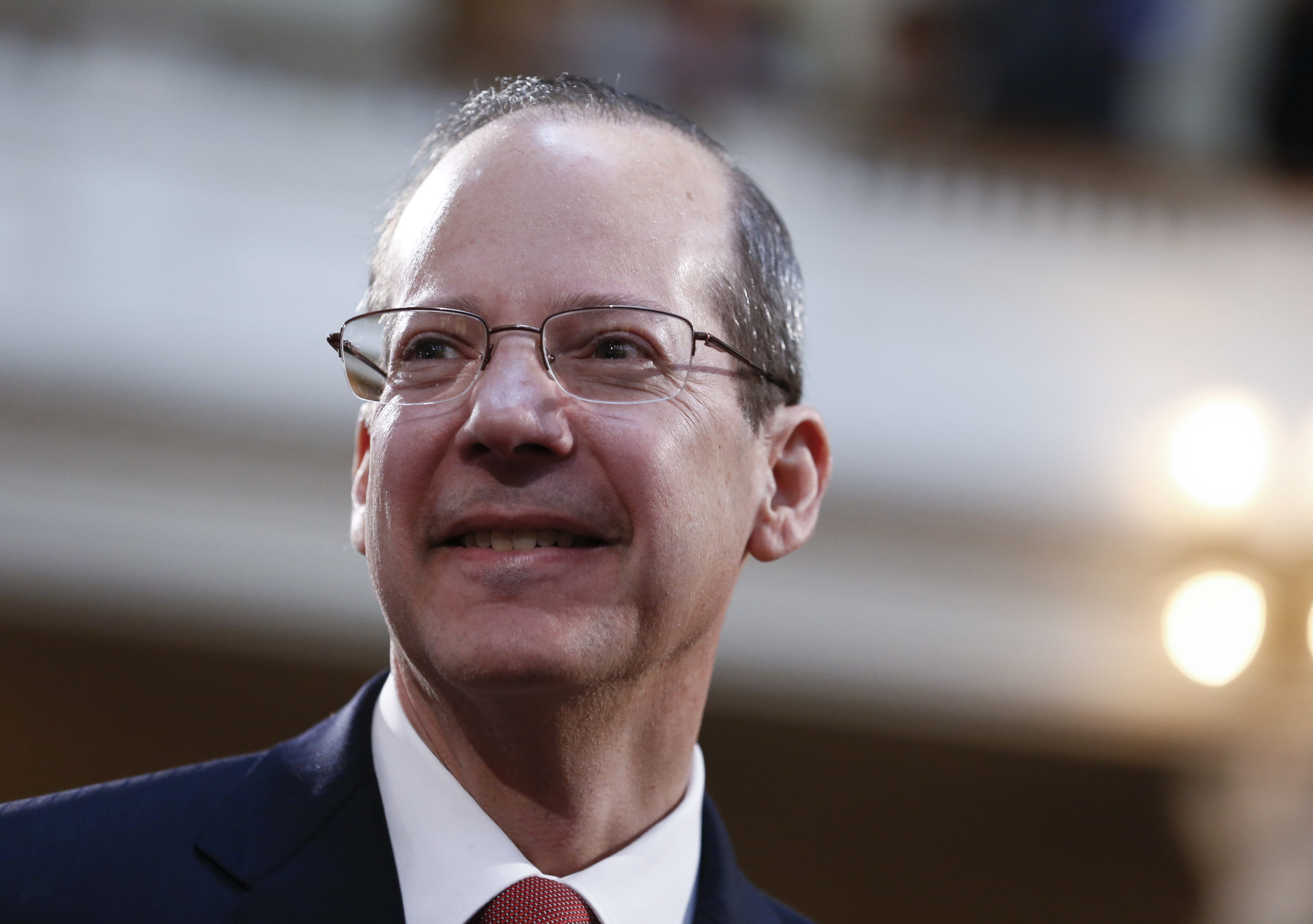Political Report
Some Supreme Courts Are Helping Shrink Jails to Stop Outbreaks. Others Are Lagging Behind.
In several states, supreme courts issued direct orders to reduce arrests and release people over the past week.

Supreme courts in several states have issued direct orders to reduce arrests and release people in the name of public health.
Kentucky Supreme Court Chief Justice John Minton Jr. warned of “potential disaster” in a March 20 letter to state judges about the coronavirus epidemic: “Kentucky’s overcrowded jails desperately need our attention,” he wrote. “Much like nursing homes, jails are susceptible to worse-case scenarios due to the close proximity of people and the number of pre-existing conditions. … It’s our responsibility to work with jailers and other county officials to safely release as many defendants as we can as quickly as we can.”
That same day, Montana’s chief justice instructed his state’s judges to “review . . . jail rosters and release, without bond, as many prisoners as you are able.” California’s chief justice issued a statewide advisory of her own asking judges to lower bail amounts, “including to $0 for many lower level offenses,” and to allow early release for people with less than 60 days remaining on a jail sentence.
The supreme courts in New Jersey, South Carolina, Washington, and Wyoming took stronger action still over the past week, issuing direct orders to reduce arrests and release people.
As legal systems fundamentally at odds with the mandates of “social distancing” grapple with a virus that poses heightened dangers in courts, jails, and prisons, state supreme courts have come front and center. They have unique capacity to trigger far-reaching change given their power to set policies and their role in supervising and providing guidance for all lower courts. And in the last week, some have been rethinking incarceration by advocating or adopting policies that more closely align the criminal system with the demands of public health.
This kind of leadership is critical, Udi Ofer, director of the ACLU’s Justice Division, told the Appeal: Political Report. Given the decentralized nature of American courts, “there’s a tremendous need for state leadership,” he said. “It would be impossible to go county by county, city by city right now to save us from this overwhelming health crisis. We need leadership from the top, and clear guidance to local authorities and officials,” whether it comes from “chief justices or governors.”
The novel coronavirus is already inside American jails and prisons, with confirmed cases of COVID-19 among both incarcerated people and staff. Around the country, advocates and public defenders—joined now in many places by prosecutors, police, and sheriffs—have been scrambling to release as many people as possible to avert humanitarian disaster. In some places, these efforts have met resistance from various public officials, including judges.
State supreme courts have led or collaborated in these efforts to varying degrees. And in some cases, they have corrected lower courts’ refusal to integrate this public health emergency into their decisions about who should be incarcerated and why.
So far, they’ve done so in three ways: ordered the release of people already serving jail sentences, targeted unnecessary pretrial detention, and blocked some warrants to lessen new arrests.
The most sweeping and direct action so far came Sunday in New Jersey, when Chief Justice Stuart Rabner ordered the temporary release of everyone serving a sentence in county jails across the state.
Rabner approved an agreement between the state attorney general, the County Prosecutors Association of New Jersey, the Office of the Public Defender, and the ACLU of New Jersey. And while it permits prosecutors to challenge release for specific individuals by citing public safety concerns, the order could affect up to 1,000 people, according to the ACLU of New Jersey. This order does not cover people in jail pretrial.
In South Carolina, Chief Justice Donald Beatty targeted pretrial detention in an order to release anyone charged with a non-capital offense “on his own recognizance without surety.” The order contains exceptions for people who present an “unreasonable danger to the community” or are an “extreme” flight risk. As of Wednesday, nearly 200 people were released pursuant to Beatty’s order, according to an estimate by the ACLU of South Carolina.
At this stage, New Jersey’s and South Carolina’s binding orders to release people are the strongest decarceral actions taken by any supreme court; the previous directives from the chief justices of Kentucky, Montana, and California were all non-binding guidelines.
Still, they too provide new pathways to decarceration. They spell out that judges can, and should, use their discretion to release people from jail, and keep people out of jail in the first place, whether by allowing people to wait for trial at home, without paying cash bail, or by using alternatives to incarceration.
In California, for example, the chief justice instructed courts at sentencing or when setting conditions of release to consider the person’s “existing health conditions” and any “conditions existing at . . . the anticipated place of confinement that could affect the [person’s] health.”
Of course, non-binding guidance merely shifts the burden onto local judges, who can choose to disregard it. And local judges have brought vastly different politics to the table in recent weeks. In Harris County, Texas (Houston), the county’s 22 felony judges voted on Friday to “facilitate the immediate release of people” charged with some low-level felonies; by contrast, the Criminal Division of the Superior Court in Washington, D.C. made it more burdensome to request release from custody based on COVID-19. They imposed strict format requirements for motions for release, and any motions not in compliance will be denied without prejudice.
Still, Ofer observed that even nonbinding directives are hugely significant, especially when they come from a politically diverse group of states. “It shows that it’s not a red/blue issue,” he said. “Having this happen in Montana and then . . . more directly in New Jersey, it shows that it’s a bipartisan issue that needs urgent attention.”
In addition to ordering people’s release, state supreme courts have reduced arrests by restricting the use of bench warrants. Courts issue bench warrants for the arrest of people who violate court orders, such as by failing to appear at a court hearing or violating conditions of release. Enforcing such warrants during the pandemic risks crowding jails and increasing health risks.
In Washington, the state Supreme Court issued a qualified restriction on the use of bench warrants during the crisis. In a 5-4 decision, the majority ordered judges not to issue bench warrants for failure to appear (absent a determination that there is an “immediate” public safety threat). But the majority also authorized the continued use of bench warrants for violating conditions of release, which could include conduct ranging from failing a drug test to missing curfew or traveling without permission. The dissent, signed by four justices, urged the court to go further. “In this time of grave state emergency,” Justice Mary Yu wrote, “bench warrants should not issue for violations of conditions of release without a specific finding that the alleged violation poses a serious threat to public safety,” an unlikely event given that “many conditions of release” have no bearing on the safety of others, as Justice Yu pointed out.
The Supreme Court of Wyoming had adopted such a strong rule two days before. It ordered judges to issue only summonses instead of bench warrants across the board, meaning that while people may still have to show up for court at some later date, when the court system starts up again, there won’t be a warrant out for their arrest.
Advocates around the country, like in Massachusetts, are seeking similar forms of relief from their state’s highest courts.
But many high courts have remained silent, perhaps none more glaringly than New York’s.
Chief Judge Janet DiFiore has neither commented on the unhygienic conditions facilitating viral transmission inside the Rikers Island jail complex, nor offered guidance so courts can quickly process people’s release—even amid the growing outbreak inside the jail. To the contrary, she argued last month that lawmakers should narrow the state’s new bail reform law to give judges more authority to detain people at Rikers and other county jails before trial.
Roger Clark, a leader with VOCAL-NY, told the Political Report that DiFiore has shown a “lack of empathy” and concern for incarcerated people. She “should be in the middle of conversations with the governor and the mayor to figure out how many people we can safely get out, to preserve their lives” and “mitigate the risk of COVID-19 in New York City and throughout the state,” he said.
Around the country, other justices have begun to do just that.
